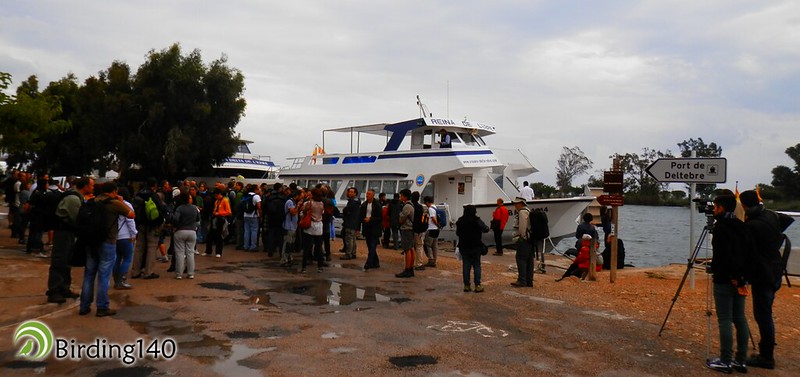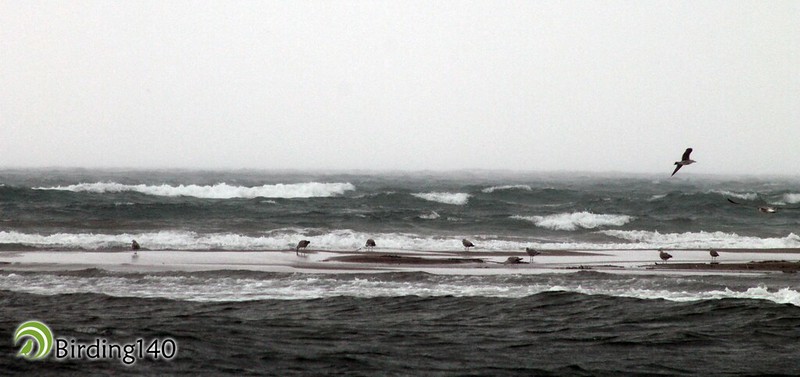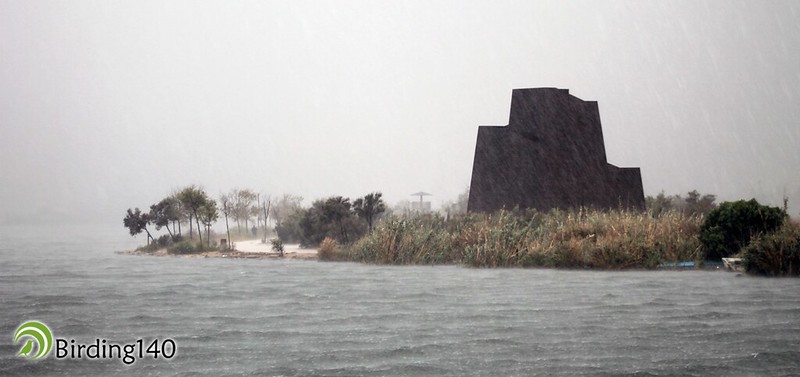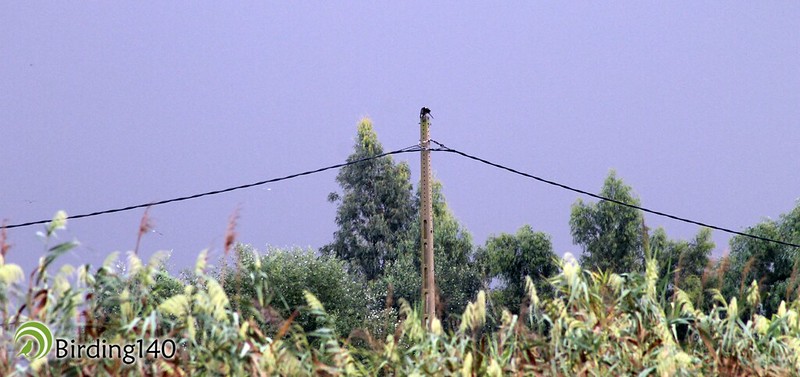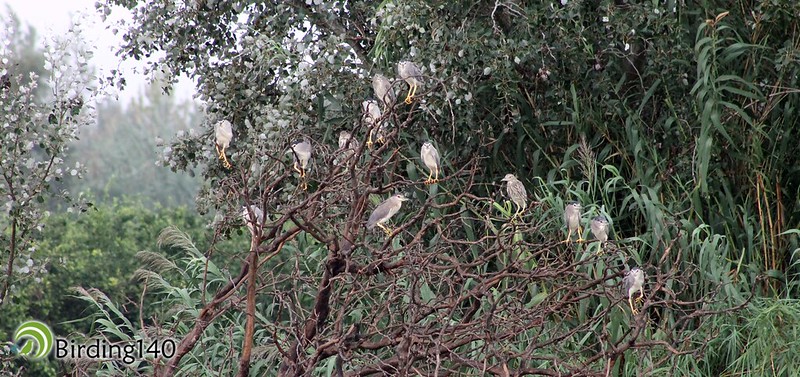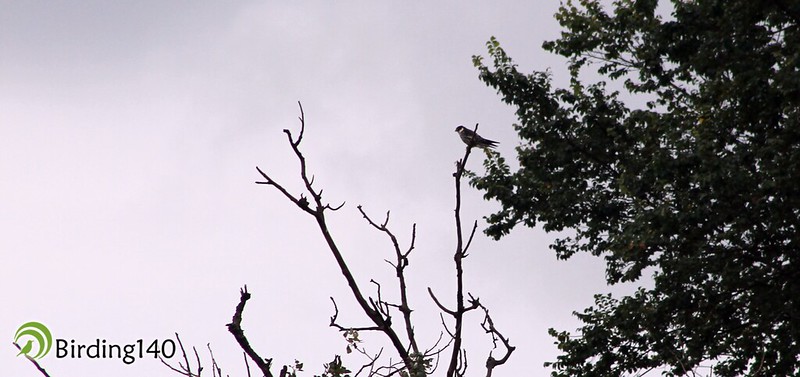On the weekend of September 27th and 28th we visited the Ebro Delta. A couple of weeks ago we talked about our impressions in MonNatura and the first edition of the Delta Birding Festival. Today we want to tell you what we did on Sunday 28th, a pure birding experience at the Ebro Delta.
Our plan for Sunday was to participate in one of the boat trips to watch pelagic birds that were organized during the Delta Birding Festival. We were eager to try to spot our first Balearic Shearwater. If we had time, we would also travel to the Riet Vell Reserve in order to know about this interesting project.
We woke up early, because we had to arrive at the Ca la Nuri quay before 9:10 if we didn’t want to miss the boat. The splendid Ebre Princess was waiting for us. The morning was really, really dark at the Ebro Delta. A Medicane (Mediterranean Hurricane) was close and threatened to give us a bath.
When we arrived at the quay, about fifty other excited passengers where already there. We would soon be about one hundred people. However, the minutes went by and we didn’t start boarding. Finally, at about 9:30, the organization of the Delta Birding Festival told us the bad news.
The mouth of the Ebro River is not so deep, and the waves of the Mediterranean made it dangerous to cross it: the hull of our boat might hit bottom, which could cause a leak. So our captain vehemently refused going out to the open sea and the trip was cancelled.
The organization offered three alternatives to the disappointed passengers. The first one, which was chosen by most people, was to make the boat trip the following Sunday. The second one was making a land vehicle visit to the Ebro Delta; and the third one, in case any passenger insisted on sailing despite the bad weather, consisted in a boat route up-river.
Once the options were suggested, our Medicane decided to show up and, suddenly, a heavy downpour forced us to shelter in the Ca la Nuri restaurant.
Sailing along the Ebro River
About half an hour later the rain dropped down, and we could finally board Ebre Princess. Although it was hard giving up the possibility of seeing our first Balearic Shearwater, we were hoping for a good birding day after all. However, it was all up to Medicane: if it didn’t clear up, the day would be a complete failure.
Our improvised up-river expedition needed an improvised guide, and the organization of the Delta Birding Festival found and exceptional one at the very last moment. A group of about twenty passengers ventured on the Ebro River no less than with Ricard Gutiérrez.
We left the quay heading to the mouth of the river under the astonished look of a Little Egret that was taking shelter from the drizzle in the opposite river bank. The first think we spotted, apart from the black horizon, was the silhouette of a female Peregrine Falcon on top of one of the trees of the river bank.
In the nearby rice fields, perched on the ground, we spotted some Great Egrets and a few dispersed Glossy Ibis. We continued towards the mouth of the river, and the drizzle turned into rain. We surpassed the Zigurat viewpoint tower and approached Punta Galatxo. We couldn’t go on from there: there was a risk that the hull of Ebre Princess would hit bottom. From that place, however, the view of the violent waves was spectacular. Only a few seagulls were brave enough to take flight in such a gale. The rain became harder.
We turned back and started our trip up-river. When we surpassed the viewpoint tower again, we got struck by a flood. We could see some people, even crazier than us, getting soaking wet while trying to reach the viewpoint tower on foot. We surpassed the tower and that was it. Under the rain we could only see the boat of some fisherman making an effort to pull the nets. We just had the hope that after the storm the calm would come.
Thus was it. As we went up the Ebro River, the intensity of the rain was decreasing. We returned to the section of the river where the Ca la Nuri quay is located, and from that moment on the clouds started to open up. On a rice field we spotted an interesting concentration of Little Egrets and two, three and four Grey Herons. Our luck was changing. And did it change!
Suddenly, at the bottom of one of those rice fields, about thirty Glossy Ibis started to cross the sky. It seems impossible that, less than ten years ago, the Glossy Ibis was a nearly extinct rarity in Europe, and nowadays its population has recovered, in the Ebro Delta as well. But the biggest surprise of the trip was still to come. Suddenly someone yelled: Eleonora’s Falcon!
Before our very eyes, a specimen of Eleonora’s Falcon perched on a pole near the river bank. We found it amazing to spot such an aloof bird in a day with such bad weather. The morning was slowly lighting up and the birds were encouraged to take flight. On the shore we could see a beautiful little Common Kingfisher; a Common Kestrel and several Glossy Ibiss flocks also flew over us.
We continued up-river. We left Deltebre on the right and Sant Jaume on the left, crossing the emblematic bridge that connects them. Then we spotted a bird we weren’t expecting to see. A domestic peacock was pecking the grass of the garden of one of the last houses of Deltebre. It was a curious picture.
We could also see part of the deterioration of the river. Practically all the trunks and logs that protruded out of the water were infested with the rosy layings of golden apple snails. This invasive species, originating from South America, causes serious damage in the rice fields, and it is a plague in the Ebro Delta. Its large size prevents natural predators from controlling its expansion.
As we were moving forward into the delta, we could see more and more Black-crowned Night Herons. First a specimen, then a couple, and later little flocks. Those signs indicated that we were approaching Isla de Gracia.
Isla de Gracia
When we reached the island, we got speechless by the large colony of Black-crowned Night Herons that it hosts. Some of them, perched on the branches, followed our boat with their eyes. This time, we were the ones being watched. When we arrived to the return point of our trip, we had a new surprise. In a naked tree we could spot the shadow of a bird and, no… it wasn’t a Black-crowned Night Heron. It was a bird of prey.
As Ebre Princess veered to return down-river to Ca la Nuri, we thoroughly observed the mysterious shadow and tried to identify it… It was a falcon… a Eurasian Hobby! It is a magnificent migratory bird that spends the winters in Africa and which, in a few days, would start its migration leaving the Ebro Delta to cross the whole African continent. Finding this bird of prey was such a surprise.
Once Ebre Princess was in position, we started our trip back. Now the sky was bright and there was no trace of Medicane. Flocks of Black-crowned Night Herons and Glossy Ibis flew over the boat. When we were close to Ca la Nuri, we spotted again the female Peregrine Falcon we had seen at the beginning of our birding trip. We said goodbye to her and to our wonderful guide Ricard Gutiérrez, and we rushed to disembark.
During the first hours of the morning, our birding day had been uncertain, but it turned out to be fantastic. We still had the evening though, and we had a plan: visiting the Riet Vell Reserve. We needed to hurry and eat fast in order to make it in time to our afternoon guided visit. But that is another story that we will tell you about in our next post.

